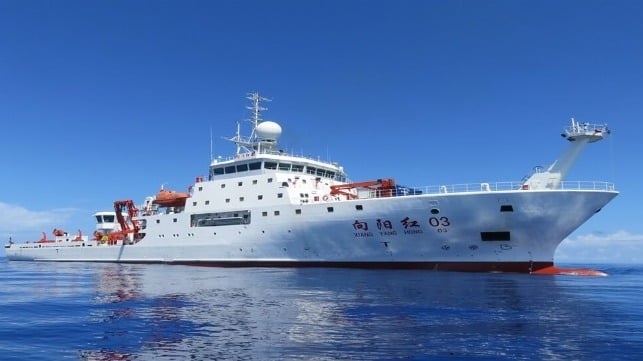Study: China’s Research Vessels Carry Out Covert Missions for PLA

Days after Sri Lanka imposed a one-year moratorium on Chinese research vessels from docking in the country’s ports, a U.S think tank is lifting the lid on clandestine missions that are carried out by China's research ships. Though it is widely believed that China has been using research vessels to advance its military and spying operations, this belief is now being laid bare in a new study.
China has developed the world's largest fleet of civilian research vessels, which have been clocking thousands of miles of expeditions to advance Beijing’s understanding of oceans, including the vast Indian Ocean. Though the core mission of the ships is to pursue scientific and commercial objectives, they are also being used to advance China’s strategic ambitions, according to the Washington-based Center for Strategic and International Studies (CSIS).
Over the past four years, CSIS has been monitoring the activities of China’s oceanographic missions, identifying 64 active research and survey vessels whose operations span across the globe. Using satellite imagery collected by the Windward Intelligence Platform and open-source data analysis, the project illuminates new details in the story of China’s expanding international influence, focusing on areas left out in Beijing’s official narrative of research vessels activities.
CSIS asserts that of the 64 active vessels, over 80 percent demonstrated suspect behavior or possess organizational links suggesting their involvement in advancing Beijing’s geopolitical agenda. A total of 52 vessels displayed at least two warning indicators.dss
The think tank was able to validate its assertions that China is using research vessels to advance military strategies through the activities of three vessels. One of them is the Xiang Yang Hong 06, which traveled more than 10,000 kilometers over 110 days to survey vast swaths of the Indian Ocean in 2019 and 2020. The underwater gliders and floats deployed during the mission are believed to covertly advance security and military activities.
A four-month ocean bed mapping mission in early 2023 by the seismic survey ship Hai Yang Shi You 760 is another example, as the seismic and bathymetric data collected could be of significant value to the People’s Liberation Army (PLA). A research mission by Shiyan 06 in the eastern Indian Ocean in October last year is another case. The vessel is operated by the South China Sea Institute of Oceanology, an institute that has provided technical and logistical support for China’s?militarization of the South China Sea.
CSIS contends that the PLA is able to leverage the insights gained from these missions to enhance its knowledge of the dynamic undersea environment, a crucial precursor to confidently deploying naval forces abroad.
“China is not alone in applying oceanographic research to support military needs. Yet the scale of China’s activities is immense, and the line between its civilian and military research is heavily blurred,” states the report.
The report adds that while China’s surveying operations have been heavily concentrated along its maritime periphery in the South China Sea and western Pacific Ocean, Beijing has also set its sights on the Indian Ocean, an emerging arena of competition with India. Over the past four year, 13 Chinese research vessels have been active in the Indian Ocean region. All have links to China’s military, including organizational ties to the PLA, and demonstrate questionable activities at sea and in port.
New Delhi was instrumental in pushing Sri Lanka to impose a one-year moratorium on Chinese research vessels from docking in its ports, warning of their potential impact on security and strategic concerns for the countries.
CSIS highlights that while Beijing’s lack of transparency makes it challenging to discern the true nature of its survey operations, three specific indicators shed light on which vessels may be supporting its military and national security objectives.
The first is vessel ownership and type. Evidently, the study shows that many of China’s research vessels are owned and operated by state-affiliated organizations with close ties to the Chinese military. For example, the Ministry of Natural Resources and Chinese Academy of Sciences both operate research vessels and have signed cooperation agreements with the PLA.
More critically is that some survey ships were in service with the PLA before entering civilian service. A case in point is the Xiang Yang Hong class, whose hulls were originally built for the Chinese navy but were later transferred to civilian authorities with ties to the PLA. Other ships are operated directly by the China Coast Guard, which ultimately reports to the country’s Central Military Commission.

that matters most
Get the latest maritime news delivered to your inbox daily.
The second is military-affiliated port visits. On this, many Chinese survey ships have a record of calling at ports in military-affiliated facilities like Sanya, Guangzhou, Qingdao and other ports known to host major contingents of PLA Navy warships and maritime militia vessels. Some have also visited China’s unlawfully constructed military outposts in the South China Sea.
The last is activities. The study avers that behavior at sea can raise red flags particularly owing to China’s research vessels’ penchant for “spoofing” (providing falsified identification information) or “going dark” (turning off automatic identification system signals for extended periods). For China’s research vessels, these activities occur frequently, sometimes near foreign military facilities.
